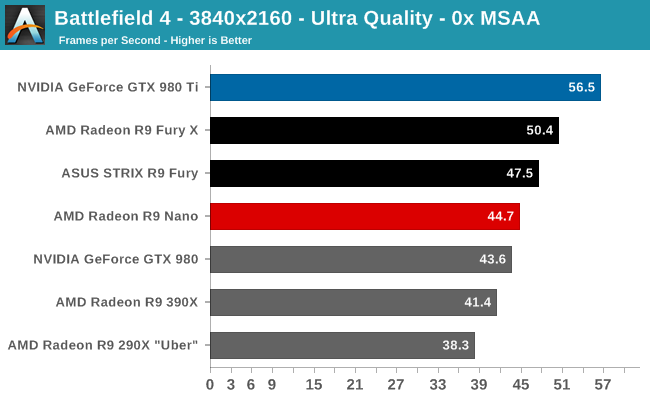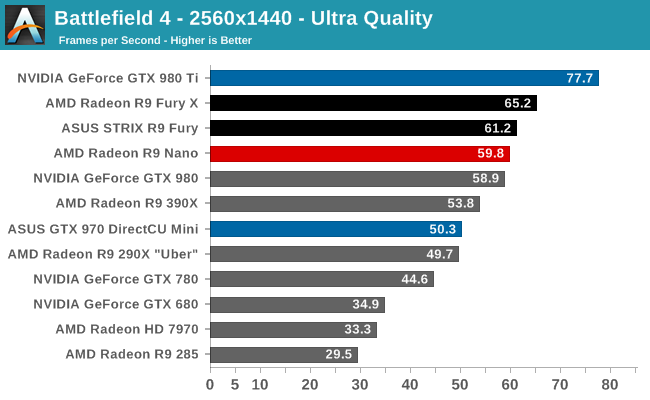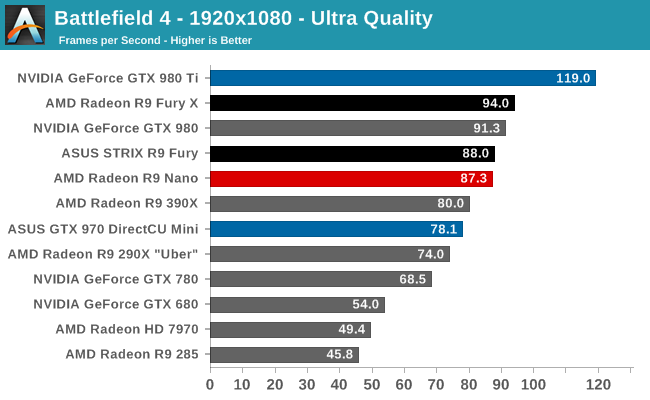The AMD Radeon R9 Nano Review: The Power of Size
by Ryan Smith on September 10, 2015 8:00 AM ESTBattlefield 4
Kicking off our benchmark suite is Battlefield 4, DICE’s 2013 multiplayer military shooter. After a rocky start, Battlefield 4 has since become a challenging game in its own right and a showcase title for low-level graphics APIs. As these benchmarks are from single player mode, based on our experiences our rule of thumb here is that multiplayer framerates will dip to half our single player framerates, which means a card needs to be able to average at least 60fps if it’s to be able to hold up in multiplayer.




Like the other Fiji cards, AMD is promoting the R9 Nano in part on its 4K capabilities. And while we disagree that this card is suitable for 4K gaming based on its sub-Fury performance, we’re including 4K results anyhow to serve as a point of comparison.
In any case Battlefield 4 is often a good indicator of general card performance, and for the R9 Nano this is no exception. What we find is that the R9 Nano trails the other Fury cards in all cases. However to our initial surprise, the R9 Nano sticks rather close to the R9 Fury. The petite powerhouse trails the R9 Fury by only 1-6%, which for the record is a smaller gap than we were expecting.
While the R9 Nano packs a full Fiji GPU, AMD has to pull back on clockspeeds to hit their power targets; in the case of Battlefield 4 this is an average clockspeed of just 879MHz at 2560x1440. Given this we had been expecting the R9 Nano to deliver around 85-90% of the performance of the R9 Fury (and about 80% of the R9 Fury X), based on the assumption that average clockspeeds would be closer to 800MHz. So the fact that the R9 Nano starts off as close to the R9 Fury as it does – even if it’s still trailing it – is a pleasant surprise.
Otherwise with performance still clearly occupying a position as a “3rd tier” Fiji card, I’m not sure if anything about these results should be surprising. On a price/performance basis AMD is not intending to be competitive with other $650 cards, so the R9 Fury X and GTX 980 Ti are of course on the top of the heap. What you get instead is a card that delivers around 90% of R9 Fury X’s performance in BF4 with much less power consumption.
Moving on, compared to the lower power and smaller cards, the R9 Nano is as expected a clean sweep. Demonstrating the virtues of a wide and lower clocked processor’s ability to deliver strong performance without requiring extreme power, everything from the R9 285 to the GTX 980 trails the R9 Nano here. Compared to the GTX 970 Mini in particular, the R9 Nano is 12-26% faster depending on the resolution.
The one potential problem here for the R9 Nano is the GTX 980. Though not a Mini-ITX card, the GTX 980’s power consumption is going to be fairly close to the R9 Nano’s, definitely more so than GTX 970’s. From a power efficiency standpoint it’s the GTX 980 that poses the greatest challenge to the R9 Nano, and while it’s ahead of the GTX 980 in this case at 2560x1440 and higher, it’s a sign that AMD should be worried about what could happen if an NVIDIA partner produced a Mini-ITX GTX 980.










284 Comments
View All Comments
Will Robinson - Thursday, September 10, 2015 - link
Yup,I agree.Dammed with faint praise is the best you'll see for AMD cards there.
Their comments section is an NV fanboy fest led by Chuckula/Chizow and approved by TR.
silverblue - Friday, September 11, 2015 - link
Semiaccurate would've most likely gone the same way had Charlie not locked it all down to subscribers. The only downside is the lack of a daily drashek fix.I think wccftech is another of chizow's haunts, but don't quote me on that.
Gasaraki88 - Friday, September 11, 2015 - link
Oh come on. AMD didn't give a card to Kyle from HardOCP also. So you're saying all the review sites out there are bias against AMD?jardows2 - Friday, September 11, 2015 - link
After reading several recent H's reviews of AMD products, where their testing shows the AMD card slightly slower than the nVidia product, then the conclusion stating the AMD product is a piece of trash and not worth anyone's money, without any of their own testing data backing up such a harsh conclusion, I don't blame AMD for not sending them a card.Alexvrb - Friday, September 11, 2015 - link
Yeah I kind of saw that one coming. I still read H sometimes, but you really have to draw your own conclusions and keep the salt handy. With TR, it's not only what they report, it's what they refuse to report. It's far from the worse, but there's a pattern.AT is my favorite overall, anyway.
InquisitorDavid - Saturday, September 12, 2015 - link
I don't know what your level of 'recent' is, but the R9 380 and R9 390x both got decent reviews. The 390x got a silver award, basically being touted as a cheaper, more power-hungry 980 with more VRAM (truth), and the R9 380 was given a Gold award because it performed better than a 960 at the same price range.The Fury got no awards for being on-par with the stock 980, while costing more. They saw the 390x having better value (thus the silver award), despite the increased power draw.
If anything, AMD has been getting a lot of crap because they've been losing for a while now. Less efficiency, rebrands, and all. OC'ing the 390x gets it to the same level as a 980 reference, and will consume about 200w more. It's cheaper, however, and we all know that's what AMD has been doing for a while now - value for money. It's the only battlefield they can claim any sort of real victory on. With the Fury and Nano, that gets completely thrown out the window.
The Fury X was hamstrung by the release of the 980ti (which was clearly a blocking maneuver by NV). Without the 980ti, it would've been the king of value. The "overclocker's dream" statement was still a bald-faced lie.
althaz - Monday, September 14, 2015 - link
If prices are equal and the AMD card is slightly slower, then the AMD card *IS* worthless. Who would pay the same money to get slightly worse performance and use more power? Only idiots.althaz - Monday, September 14, 2015 - link
Anybody that hasn't been pro-nVidia for the past few years has been doing it wrong. AMD have been using more power to offer less performance (at similar prices) - they have been behind for *ages* now. They still are, but at least it looks like HBM will bring the performance needed (next generation probably, it's obviously not there yet).anubis44 - Thursday, October 8, 2015 - link
I like TechReport, and find their coverage of tech very detailed, but yes, I have to agree with you that they've essentially been portraying AMD as just not quite as good as nVidia, yet all the while minimizing or ignoring the Green Goblin's dubious business practices ($200 G-Sync tax) and misrepresentation of their products (the 3.5GB GTX970 that somehow didn't completely torpedo that card's recommendation).Frenetic Pony - Thursday, September 10, 2015 - link
I've looked at Tech Report, fuck Tech Report. None of their tests seem to reflect anyone elses, I tried a few of the graphs and they're literally a statistical outlier (at least for my quick tests).